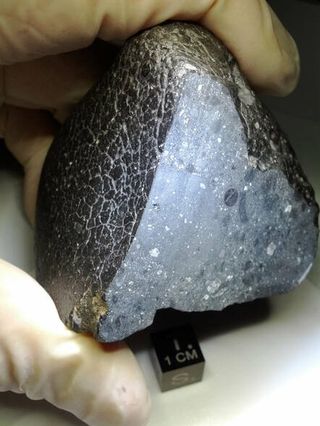Mars' oldest meteorite tracked to bizarre double impact crater
Researchers have tracked the oldest known Martian meteorite to its precise point of origin using artificial intelligence (AI), and the findings could help reveal what conditions were on our planet. solar systemthe planets were like during their first days.
The 11 ounce (320 gram) meteorite, officially nicknamed Northwest Africa 7034 but commonly known as “Black Beauty,” is believed to have hit Earth about 5 million years ago. After being discovered in the Sahara Desert in 2011, its age was estimated to be just under 4.5 billion years – making it the oldest Martian meteorite ever found on Earth.
Scientists believe the meteorite was launched to Earth after a powerful asteroid impact hit Mars, tearing apart parts of the planet’s crust and spraying it into space. Now, using machine learning algorithms to identify and catalog the 94 million craters on Mars, researchers have traced the origins of Black Beauty to small craters within craters in Mars’ southern hemisphere. Scientists named the Karratha crater after the Australian mining town where many of the oldest rocks on Earth have been found. They published their findings July 12 in the journal Nature Communication (opens in a new tab).
Related: Giant ‘hidden water’ reservoir discovered on Mars
“Finding the region where the ‘Black Beauty’ meteorite originated is very important because it contains the oldest Martian fragment ever found, 4.48 billion years old, and it shows similarities between the very old Martian crust, around 4.53 billion years old, and the continental crust. Earth today,” lead author Anthony Lagain, a planetary scientist at Curtin University in Perth, Australia, said in a statement. “The region we identified as the source of this unique Martian meteorite sample represents a true window into the earliest planetary environments, including Earth, that were lost to our planet. tectonic plates and erosion.”
To identify the meteorite’s starting point, the researchers fed images of 94 million Martian craters captured by the Mars Reconnaissance Orbiter’s context camera into a machine learning algorithm. The AI cross-referenced the size and distribution of the craters with the material properties of wild meteorites – which have some of the highest concentrations of potassium and thorium of any Martian meteorite found on Earth, and are among the most magnetized. This narrowed the list of possible craters to 19, one of which stood out to the team because it perfectly matched the chronology of the Martian collision and the nature of the meteorite.
By studying the impact crater, scientists discovered that Black Beauty was sent to Earth thanks to two asteroid impacts. The first – which hit Mars and formed the 25-mile-wide (40-kilometer) Khujirt crater roughly 1.5 billion years ago – violently tore Black Beauty and other rocks from the Martian crust, sending them high into the atmosphere before raining again. to the surface of the Red Planet. Then, after a 5 to 10 million year gap, a second impact sent Black Beauty flying through space towards Earth and leaving Karratha crater inside Khujirt crater.
The findings suggest the rock was once part of Mars’ primordial crust – the original crust of the Red Planet that formed soon after the magma ocean cooled and solidified. As plate tectonics shattered the ancient Earth’s crust, and the original moon’s crust was buried under thousands of meters of lunar dust, these craters are of great interest to scientists who want to study how the bodies of our solar system first formed.
Not only was the algorithm able to locate the ejection locations of other Martian meteorites, the researchers said they would also like to adapt their algorithm to perform similar searches on the moon and Mercury.
“This will help unravel their geological history and answer burning questions that will aid future Solar System investigations such as the Artemis program to send humans to the Moon by the end of this decade or the BepiColombo mission, in orbit around Mercury in 2025.” ,” said co-author Gretchen Benedix, a planetary scientist at Curtin University in the statement.
Originally published in Live Science.
#Mars #oldest #meteorite #tracked #bizarre #double #impact #crater

Comments
Post a Comment